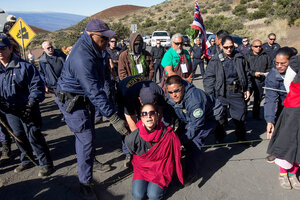Hawaii court nulls Thirty Meter Telescope permit: Victory for Native Hawaiians?
Scientists and Native Hawaiians have clashed over the construction of the Thirty Meter Telescope on Hawaii's Mauna Kea. Wednesday's ruling ensures that locals will have a formal chance to voice their protest.

Department of Land and Natural Resources officers arrest a protester on the road to Thirty Meter Telescope building site on the summit of Mauna Kea in Hilo, Hawaii, April 2. The Hawaii Supreme Court halted construction on the telescope Wednesday after ruling that the state had not allowed protesters a forum to voice concerns prior to issuing the permit.
Hollyn Johnson/Hawaii Tribune-Herald/AP
Hawaii’s Supreme Court invalidated a construction permit for the Thirty Meter Telescope Wednesday, a $1.4 billion observatory planned for the peak of Mauna Kea: the state’s tallest mountain and a cultural icon for Hawaiian natives.
The path to the Court’s decision Wednesday has been fraught with conflict. Native Hawaiians who consider the mountain sacred staged a number of local protests, several of which ended in arrests and property damage. The state Department of Land and Natural Resources (DLNR) eventually enforced an emergency rule restricting access to the mountain during night hours, as The Christian Science Monitor reported in early September.
But the Supreme Court’s long-awaited decision suggests the power of Native Hawaiians’ peaceful protests within a heavily continuous issue.
“Quite simply, the board put the cart before the horse when it issued the permit before the request for a contested case hearing was resolved and the hearing was held,” the court’s 58-page opinion held. “Accordingly, the permit cannot stand.”
Per the ruling, Hawaii’s Board of Land and Natural Resources erred in 2011 when they approved the permit because protestors were unable to share their argument. Although protestors were granted the right to a contested hearing, the board approved the TMT building permit before the hearing was scheduled, “prompting one justice to liken the events to a judge ruling before the trial occurs,” Astronomy magazine explains.
Without a court audience native Hawaiians have made their contested arguments heard by blocking roadways and staging prayer-ins.
“I’m just very grateful to the heavens and the court and the people,” Kealoha Pisciotta, one of the plaintiffs in the lawsuit challenging the permit, told the Associated Press. “The people took a stand and that’s significant. They did it without violence, peacefully. And that’s a blessing.”
Henry Yang, the Chair of the TMT International Observatory Board of Directors, made clear in a press release Wednesday that TMT respects the Supreme Court’s decision, but will continue press ahead with its bid for a permit.
“TMT will follow the process set forth by the state, as we always have,” Mr. Yang said in a statement. “We are assessing our next steps on the way forward. We appreciate and thank the people of Hawaii and our supporters from these last eight-plus years.”
Directors of the TMT chose the site of Mauna Kea because its high altitude, low light pollution, and particular air currents offer some of the clearest skies in the world.
“This is not a judgment against T.M.T., but rather against the state’s process in granting the permits,” the telescope’s affiliated Twitter account made clear Wednesday. The court’s decision does not prohibit the TMT collaboration from re-applying for another permit.
This report contains material from the Associated Press.

